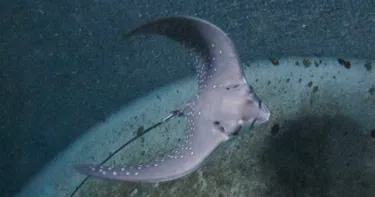Ani has now joined the aquarium’s main eagle ray oceanarium
- Thursday 28th February 2019
- Stingrays, Sea Life

Our miracle Eagle Ray – and the oldest known clone of her kind - Ani, has this week been reunited with her mother and is excited to meet her new friends – fishy and human alike!
After demonstrating excellent health, swimming and eating abilities, as well as all the habits of a happy and healthy baby Eagle Ray, our team concluded Ani was in perfect condition to join the aquarium’s main Eagle Ray oceanarium and be reunited with mum, Freckle.
“We’re so excited to share our little miracle Eagle Ray with the world!” says Libby Eyre, Senior Aquarist and Ani’s primary (human!) carer.
“Ani has taken to her new surroundings swimmingly, and is now getting to know her new tank-mates. This includes seven other female ocellated Eagle Rays – including her mum, Freckle - and many colourful tropical fish.
“Interestingly, of all her new fishy friends, Ani’s mother was the only one to react when Ani moved into the oceanarium. Whenever Ani came near, Freckle kept her distance! However after a little bonding time, the mother and daughter can now be spotted swimming together in our Dugong Island exhibit. It’s really the most adorable sight to see, and after national and global interest in Ani, and guests asking about her, we’re so happy to the public can come in and meet the bub for themselves!”
Once the miracle ray has comfortably settled into her new home, she will be incorporated into further training to learn a range of husbandry behaviours that will assist her development.
On 26th July 2018, our eleven year old female Eagle Ray, Freckle, gave birth to Ani in a rare scientific phenomenon, despite not having contact with a male for over nine years. Freckle demonstrated a cloning process called parthenogenesis and the bub adopted her fitting name after Anakin Skywalker - better known as Darth Vader - who also had no father.
Ani will serve as an ambassador for her species, and her exceptional conception has helped expand our team's already extensive knowledge of this species and will further assist in their ongoing husbandry.
Guests can now meet Ani the miracle ray in the Dugong Island exhibit. (You can’t miss her - she’s the tiny little spotted ray, who is super cute!)

About Parthenogenesis
The term parthenogenesis is taken from the Greek words parthenos, meaning “virgin,” and genesis, meaning “origin.”
How rare is parthenogenesis in Eagle Rays?
Parthenogenesis has been documented in a similar species, the spotted Eagle Ray (Aetobatus narinari) as well as ocellated eagle rays (Aetobatus ocellatus) in The Netherlands. However, it is uncommon. Burgers' Zoo in The Netherlands has had 5 young born to parthenogenesis, but none survived. It's important to remember that sexual reproduction is the normal mode of reproduction in these animals, and parthenogenesis means that the genetic diversity in the offspring is reduced, making them less robust to the challenges of the world.
Parthenogenesis in other species
Facultative parthenogenesis (when a sexually producing species switches to asexual reproduction) is known in snakes, lizards and even some birds. It has now been experienced in sharks and rays in human care, including sawfish, white tip reef sharks, blacktip sharks, bamboo sharks, leopard sharks, and spotted eagle rays.
About Libby Eyre, Senior Aquarist at SEA LIFE Sydney Aquarium
Libby Eyre has worked in the animal care industry for over thirty years, working mainly with marine animals. She specialises in providing training and enrichment for a variety of species. She has a degree in biology, and research interests in humpback whales. She has been at SEA LIFE Sydney Aquarium for ten years.